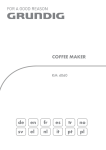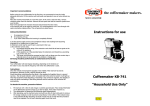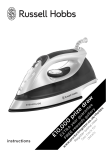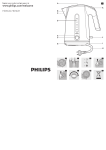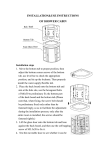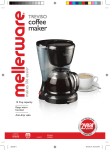Download Instruction Manual for R-917 Important safeguards
Transcript
Instruction Manual for R-917 Important safeguards page: 1 of 4 1. Please read these instructions carefully before use the appliance and save it for future reference. 2. The appliance is not intended for use by persons (including children) with reduced physical, sensory or mental capabilities, or lack of experience and knowledge, unless they have been given supervision or instruction concerning use of the appliance by a person responsible for their safety. 3. Children should be supervised to ensure that they do not play with the appliance. 4. Do not immerse the supply cord, plug, or appliance itself in water or any other liquids. 5. The appliance should only be connected to an earthed socket. Make sure the voltage indicated on the 6. Never let the machine operate while unattended. 7. The supply cord should be regularly examined for signs of damage. If the supply cord is damaged, it must appliance corresponds to the local mains voltage before plugging in. be replaced by the manufacturer, its service agent or similarly qualified persons in order to avoid a hazard. 8. Do not operate the appliance with a damaged cord or plug, or after the appliance malfunctions, or has been damaged in any manner, return appliance to the nearest authorized service agent for examination, repair or adjustment. 9. This appliance is intended for household use and similar applications such as: –staff kitchen areas in shops, offices and other working environments; –farm houses; –by clients in hotels, motels and other residential type environments; –bed and breakfast type environments. 10. Never use the appliance outdoors and always place it in a dry environment. 11. Always remove the plug from the socket in case of any malfunction, before filling or after use, or before cleaning. 12. Do not allow the appliance or its supply cord to touch hot surfaces or to come into contact with any heat sources. 13. Keep the supply cord out of reach of children or incompetent persons. Never unplug or move the appliance by pulling the cord. Do not wind the cord around the appliance or twist it. 14. Stand the appliance on a stable, flat surface. 15. Never touch the hot parts of the appliance (be careful, also the warm plate or warm plate is a hot part!). Only take the jug by the handle. 16. Be careful not to get burnt by the steam evaporating from the filter. 17. Never use your coffee maker without water in it. Only use fresh and cold water to brew coffee. 18. Never fill the water tank beyond the Max. level. Do not use your coffee maker in case of overflowing. 19. Never put the jug in an oven (including microwave oven) to warm up the coffee. 20. Do not forget that the temperature of the coffee prepared is high, handle with care the jug to avoid scalding. 21. Handle with care the glass jug (if applicable) as the glass is very fragile. Never use the appliance if the jug shows any signs of cracks. 22. Never place the empty or almost empty glass jug (if applicable) on the warm plate when the coffee maker is in function, or on any other hot surfaces. 23. Never use accessories which are not recommended by the manufacturer. They could constitute a danger to the user and risk to damage the appliance. 24. Always set any control to “off” before unplugging from the socket. 25. Make sure the ambient temperature is above 0°C, otherwise the appliance does not function properly. 26. Always descale the appliance regularly to ensure optimum performance and prevent malfunction. 27. Make sure cool down before cleaning or storing the appliance. 28. The appliance may give off some smoke and smell when you use it for the first a few times because of the oil on some parts, it will disappear after a few times uses. Instruction Manual for R-917 page: 2 of 4 Technical data Ratings: 220-240V~ 50Hz, 800W Nominal capacity of water tank: 1.2L Know your coffee maker 1. Water tank cover 2. Water tank with water level indication 3. Top lid 4. Filter holder 5. Anti-drip valve 6. Glass jug 7. Warm plate 8. On/Off switch with indicator lamp Operation 1. Uncover the water tank cover and fill with fresh cold water to required level. 2. Close the water tank cover. 3. Swing out the filter holder, put adequate quantity of coffee powders into the permanent filter (if applicable) or paper filter inside the filter holder. 4. Return the filter holder to original position, make sure it is fixed properly. 5. Place the jug on the warm plate. 6. Switch on the appliance by pressing the On/Off switch, the indicator lamp will light up and now the appliance starts to work. 7. The appliance will brew until the water tank is emptied, then automatically enter into keep-warm mode. The warm plate will keep the brewed coffee warm at: 1) Above 72°C in half an hour. 2) Above 68°C in an hour. Cleaning 1. Do not forget to remove the plug from the socket and make sure cool down before cleaning the appliance. 2. Never immerse the cord, plug, or appliance itself in water. 3. Wipe outside with soft, moist cloth when appliance is cold down completely, never use metal polish. 4. Clean the permanent filter (if applicable) and other detachable parts in warm soapy water, rinse with fresh water and dry them before reassembling. 5. Clean the inside of jug with a soft brush in warm soapy water. rinse with fresh water and dry it before next use. Note: Never use a dishwasher to clean the jug. 6. Clean the appliance at least once every 3 months so as to keep high efficiency. 7. Store the appliance in a dry and not very hot place. Descaling The appliance has to be descaled regularly, otherwise the coffee taste will become bad and the scale deposited inside in the machine may cause permanent and irreparable damage to the machine. If you begin to notice the increase of the noise during boiling, or a longer time of brewing time, or the appliance switches off before the water tank is empty, these indicate descaling is necessary. Instruction Manual for R-917 page: 3 of 4 The frequency depends on the water hardness and the brewing frequency. Generally, the descaling should be done in the following periodicity: With soft water, at least once every 3 months. With hard water, at least once every month. If doubt to the water hardness, ask advice of your local tap water company. It is recommended to use only liquid descaler suitable for coffee maker, and read carefully the instructions on its package or user manual before use. 1. Mix adequate descaler with cold water in a measuring jug. Note: Never use a powder descaler. 2. Fill the water tank up to the Max level with prepared solution. 3. Operate the appliance until the water tank is empty as if you brewed coffee, but without paper filter and ground coffee in the filter holder. 4. Repeat steps 1 to 3 for another descaling cycle. Note: Never refill the water tank with the used descaling solution because it is no longer active. 5. Operate two more brewing cycles with fresh, cold water to remove all descaler solution residues. Important: 1) Never interrupt the descaling process. 2) Malfunctions caused by scale deposited inside the appliance are not covered by the guarantee if the descaling process is not carried out properly. Troubleshooting If you have a problem, you may find the solution in the table below. In case these solutions can not solve your problem yet, please contact with the nearest authorized service agent for examination, repair or adjustment. Problem The appliance does not work. Water leaks out of the appliance. The appliance produces a lot of noise and steam during brewing. Coffee grounds enter into the jug. Brewing coffee takes longer than usual. The coffee maker switches off before the water tank is empty. The coffee is not strong enough. The coffee is too strong. The coffee does not taste good. The coffee is not hot enough. The jug is difficult to place in the appliance or remove from the appliance. There is less coffee in the jug than expected. Solution Make sure the voltage indicated on the appliance corresponds to the local mains voltage. Make sure the appliance has been plugged in & switched on. Check if the water tank is filled beyond the MAX level. Make sure the water tank is not filled with hot water. The appliance needs to be descaled (see chapter ‘Descaling’). Check if the filter holder has overflowed because there is too much ground coffee in the filter, or the jug has not been placed correctly under the filter holder, or you . remove the jug for more than 30 seconds during brewing. Check if the filter is torn or you use the wrong size of paper filter. The appliance needs to be descaled (see chapter ‘Descaling’). The appliance needs to be descaled (see chapter ‘Descaling’). Check if used ground coffee is not enough. It should be one heaped measuring spoon of ground coffee for each cup. Check if you use ground coffee with mild flavour. Check if used too much ground coffee. It should be one heaped measuring spoon of ground coffee for each cup. Check if you have used ground coffee with strong flavour. Check if you leave the glass jug with coffee on the warm plate too long, especially if it only contains a small amount of coffee. Check if the brewed coffee is too little. The coffee will warm longer if you brew more. Make sure you place the glass jug properly on the warm plate. Make sure the lid of the jug & filter basket are in right position. Tilt the jug a little of angle to place or remove it. Be careful not to spill the hot coffee for avoiding scald. Check if you have no place the jug properly on the warm plate, so as to the anti-drip valve prevents the coffee from flowing out of the filter. The appliance needs to be descaled (see chapter ‘Descaling’). Instruction Manual for R-917 page: 4 of 4 IMPORTANT INFORMATION FOR CORRECT DISPOSAL OF THE PRODUCT IN ACCORDANCE WITH EC DIRECTIVE 2002/96/EC. At the end of its working life, the product must not be disposed of as urban waste. It must be taken to a special local authority differentiated waste collection centre or to a dealer providing this service. Disposing of a household appliance separately avoids possible negative consequences for the environment and health, deriving form inappropriate disposal and enables the constituent materials to be recovered to obtain significant savings in energy and resources. As a reminder of the need to dispose of household appliances separately, the product is marked with a crossed-out wheeled dustbin.




